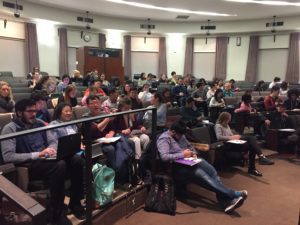

The thesis of the article, by Rhett Allain, is that modern technologies have made the traditional lecture obsolete. The traditional lecture is one during which a teacher stands at the front of the room and ‘disseminates knowledge to students’. Allain claims – rightly so – that animated videos like The Mechanical Universe are far more engaging. He suggests that, to teach physics, just show the students episodes from this show. If they have questions, just pause the show.
He claims that showing these videos – or equivalents for other subjects – beats most lectures. Lectures in which teachers drone on and on.
Well guess what – I teach a virology course at Columbia University, and at the end of the year, most of the students say its one of the best, or the best class they have taken in their college years. I don’t show The Viral Universe or any other videos during my class. I talk to the students about my knowledge of viruses, gained from researching them for over 30 years.
Not every virology lecturer has my experience in the field. Many of them learn virology from a book. I agree that lectures given by those individuals are dead.
I do record each lecture and post them at YouTube, so that the students in the class, or anyone in the world for that matter, can watch them. It’s a new technology that Allain likes. I like allowing the students to time-shift their learning: some never come to class. But it’s still me making the videos and sharing my knowledge via a traditional lecture format.
Allain is also fond of the flipped classroom – assign a video for students to watch before class, and then use class time to discuss it. I love this idea. But I still think that for my introductory virology class, it’s better for me to talk to them. To walk around the room, without notes, look them in the eye, and muster all my passion and love for the field and send it their way. And don’t think that doesn’t matter – many of my students tell me that my passion for the subject is what makes them interested in viruses.
Research says that most students learn better by doing. I do pause a few times during each lecture to have students complete an online quiz – something Allain also likes. It gives me time to see if what I’m saying is sinking in, and to clarify complex material.
When I lecture, students come to me afterwards with questions, and some even walk with me to the subway, to talk about viruses. How can a video provide that experience?
Allain’s response might be that if anyone wants to teach a virology course, just play my lectures and discuss them in class. I’m all for that. But every spring semester, I’ll be in front of the class, talking about viruses, and making new videos. There is no substitute for a expert who is passionate about their subject. I realize that every physics course can’t be taught by Einstein, but he can teach at least one, and the students at his university will love it.
Not every passionate researcher will make a great lecturer, and for them, videos and flipped classrooms are a great way to teach. But for those passionate researchers who can teach – why not put them in front of a class and inspire the next generation? I do it every year.

More than that, if this really worked as suggested by Wired, then things like the e-learning Khan Academy would have taken over education. MIT’s free courseware would have taken over. It hasn’t, and it won’t. Brick and mortar colleges have higher enrollment than ever before. OEDB used to provide graduation rates for schools, (a 4 year degree in 6 years) and had University of Phoenix listed (until I started citing them, then it disappeared.) UofPhoenix had a 4% graduation rate. And that’s graduation from a system that has had reports of rather poor fulfilment of serious requirements to demonstrate learning. Other online schools do better, but most are abysmal to poor. There has to be real engagement of students.
The Wired article is also repeating the error of the elite student’s bias. Elite students do well almost no matter what you do with them. In parts of the European system, they depend on that in graduate school programs where students may not be given any direction at all – they just have an oral exam at the end of a year or 4 years, to see if they should remain. It is up to the student to hit the library, go find professors to work with, etc..
Most people need a human conversation, and explanations that respond to them and pull them along.
Pingback: TWiV 449: The sound of non-silencing | This Week in Virology
Sometimes the old ways work best!
I remember in high school, when whiteboards were replacing the traditional black boards; the teachers would get frustrated with the whiteboards, as they constantly lagged.
Needless to say, most of my teachers would just give up and use chalk and whatever was left of the blackboard that the whiteboard didn’t cover.